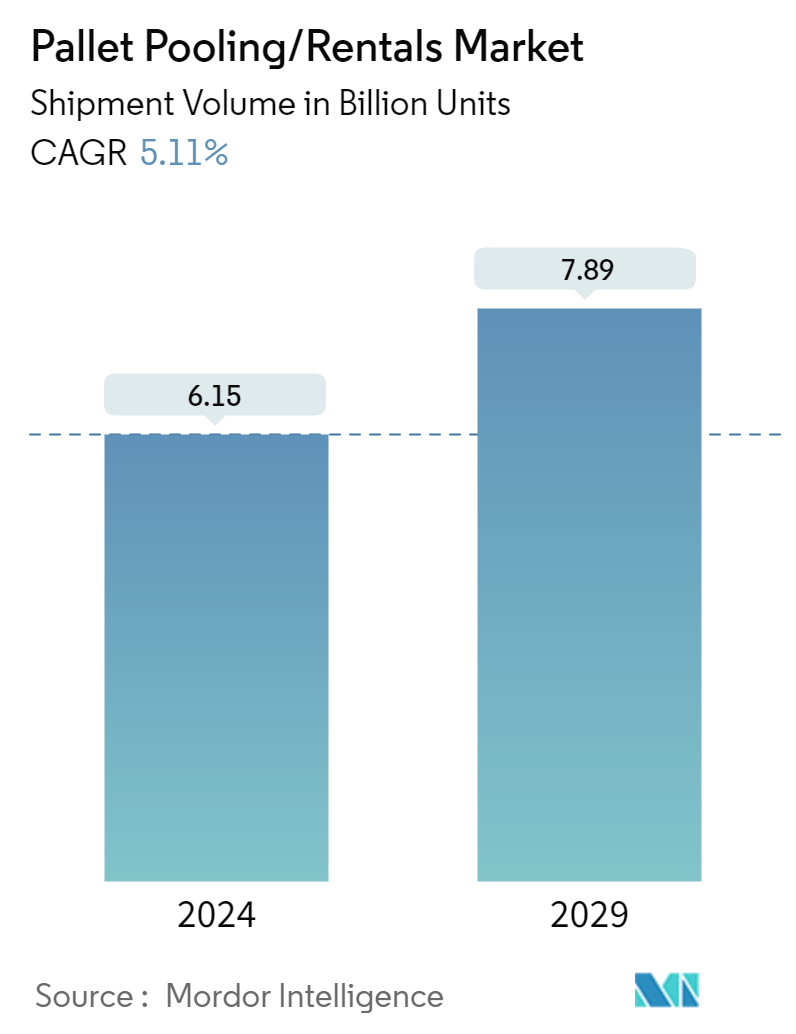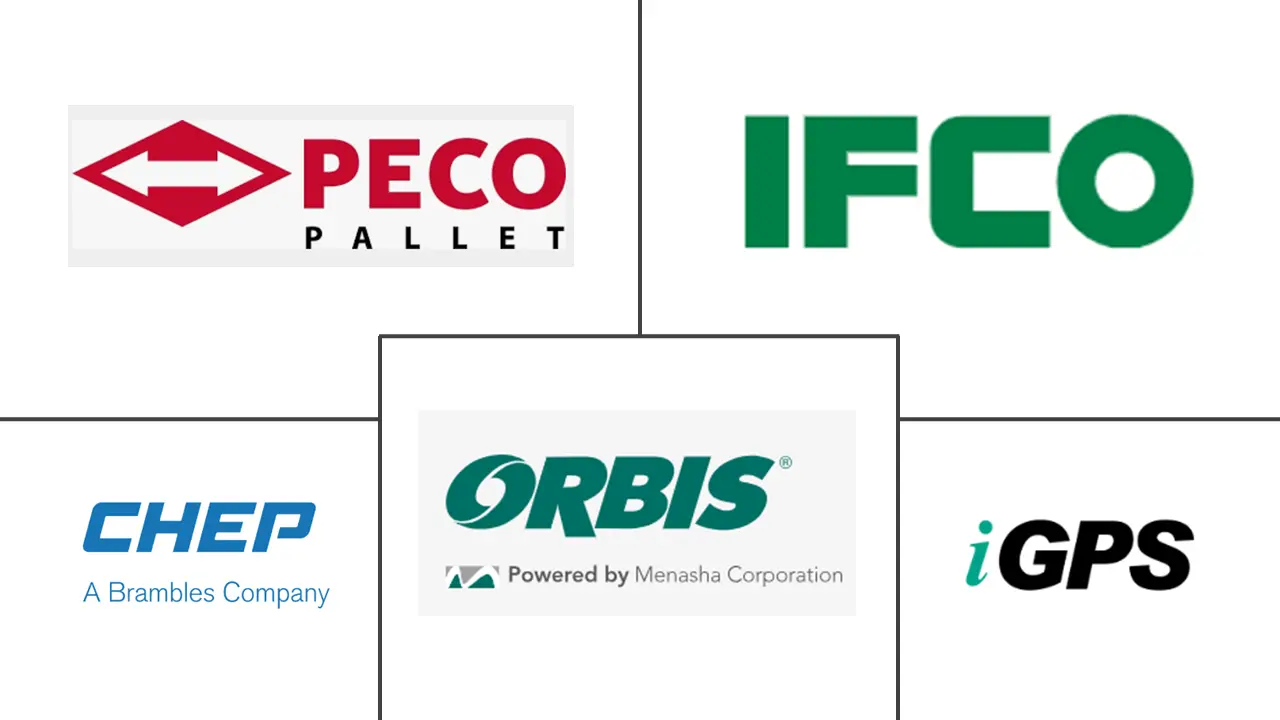Market Size of Pallet Pooling/Rentals Industry

| Study Period | 2019 - 2029 |
| Market Volume (2024) | 6.15 Billion units |
| Market Volume (2029) | 7.89 Billion units |
| CAGR (2024 - 2029) | 5.11 % |
| Fastest Growing Market | Asia Pacific |
| Largest Market | North America |
| Market Concentration | Low |
Major Players
*Disclaimer: Major Players sorted in no particular order |
Pallet Pooling/Rentals Market Analysis
The Pallet Pooling/Rentals Market size in terms of shipment volume is expected to grow from 6.15 Billion units in 2024 to 7.89 Billion units by 2029, at a CAGR of 5.11% during the forecast period (2024-2029).
- Pallet pooling/rentals is a share-and-reuse framework based on circular economy principles. It offers a sustainable and efficient alternative to traditional single-use pallets. Various pallets, such as plastic pallets, wood pallets, and others, are circulated among stakeholders, including producers, distributors, retailers, and transporters, fostering efficiency and sustainability. This method has gained traction as a pivotal pallet management strategy,
- Various key players, such as PECO, PCT, IGPS, and CHEP, are encouraging the reduction of single-use pallets and offering end users the opportunity to switch to multi-use pallets. Manufacturers such as PCT provide online platforms for pallet users to establish personalized pallet pools, fostering sustainability by connecting them directly with suppliers and customers.
- There is a rising focus on lightweight and sustainable materials in the design and manufacture of pallets. Providers in the pallet pooling sector are increasingly turning to materials such as plastic, metal alloys, composite wood, and presswood pallets. These materials provide durability and strength and align with environmental sustainability goals. Additionally, they help cut down on transportation costs and lower carbon emissions.
- Reverse logistics, encompassing product returns, recalls, and recycling, is increasingly pivotal in the pallet pooling market. Providers in this sector now offer reverse logistics solutions to aid companies in streamlining pallet returns, enhancing asset utilization, and curbing waste in their supply chains.
- Additionally, trends such as pallet stockpiling underscore the underconsumption of pallet assets. Smart pallet monitoring technologies facilitate a digital shift in the availability and usage of pallet stocks.
- However, supply chain continuity faces a significant threat due to pallet theft, which is driven by supply shortages and soaring demand. CHEP, one of the key players in the market, estimates that Europe witnesses the theft of millions of pallets annually, either with their cargo or used illicitly. Given the industry's growing dependence on pallet circularity, these losses are becoming potential disruptions to the supply chain.
- However, smart pallet monitoring minimizes losses by offering real-time data insights on shipments and pallets. These insights are channeled to a dashboard, accessible remotely, and equipped with pre-set alerts, geofencing, and tracking features. Thus, remote monitoring technology can track shipments throughout the supply chain, even in high-risk shipping zones and with high-value shipments, ensuring timely delivery and efficient pallet circulation. In case of theft, these smart monitoring systems significantly enhance the chances of recovery.
Pallet Pooling/Rentals Industry Segmentation
Pallet pooling and rentals have become increasingly popular as useful management methods for pallets globally. Advanced tracking technologies, such as RFID and barcodes, propel the pallet pooling and rental market. They facilitate real-time monitoring of pallets, leading to improved efficiency, reduced losses, and enhanced inventory management throughout the supply chain.
The pallet pooling/rentals market is segmented by pallet type (plastic, wood, cardboard, metal), end-user industry (transportation & warehousing, food & beverages, pharmaceuticals, retail, manufacturing, other end-user industries), and geography (North America [United States and Canada], Europe [France, Germany, Italy, Spain, United Kingdom, and Rest of Europe], Asia-Pacific [China, India, Japan, Australia & New Zealand, and Rest of Asia Pacific], Latin America [Brazil, Mexico, Argentina and Rest of Latin America], and Middle East & Africa [United Arab Emirates, Saudi Arabia, South Africa, Egypt, and Rest of Middle East & Africa]). The report offers market sizes and volume forecasts for all the above segments.
| By Material Type | |
| Plastic | |
| Wood | |
| Cardboard | |
| Metals |
| By End-user Industries | |
| Transportation & Warehousing | |
| Food & Beverages | |
| Pharmaceuticals | |
| Retail | |
| Manufacturing | |
| Other End-user Industries |
| Geography*** | |||||||
| |||||||
| |||||||
| |||||||
| |||||||
|
Pallet Pooling/Rentals Market Size Summary
The pallet pooling and rentals market is experiencing significant growth, driven by the increasing adoption of sustainable and efficient logistics solutions. This market operates on the principles of the circular economy, promoting the reuse and sharing of pallets among various stakeholders, including producers, distributors, and retailers. Key players in the industry, such as PECO, PCT, IGPS, and CHEP, are actively encouraging the transition from single-use to multi-use pallets, offering innovative platforms and solutions to enhance pallet management. The focus on lightweight and sustainable materials, such as plastic and composite wood, is reshaping pallet design and manufacturing, aligning with environmental goals and reducing transportation costs. Additionally, the integration of smart monitoring technologies is enhancing the efficiency and security of pallet circulation, addressing challenges like theft and underconsumption.
In North America, the pallet pooling market is gaining traction, particularly in sectors like fast-moving consumer goods, where models such as third-party rentals and the Grocery Manufacturers Association common pool are prevalent. The use of plastic pallets is increasing due to their durability, recyclability, and ability to optimize warehouse operations. This shift is supported by the region's emphasis on sustainability and cost-effectiveness, as pallet pooling systems reduce the need for new pallet production and lower costs per trip. The market is characterized by a mix of global and local players, with companies like iGPS Logistics, Orbis Corporation, CHEP, and IFCO Management GmbH leading the charge in technological advancements and research and development. Recent innovations, such as IFCO's reusable plastic pallet and ORBIS's extended-life pallet, highlight the industry's commitment to enhancing logistics efficiency and sustainability.
Pallet Pooling/Rentals Market Size - Table of Contents
-
1. MARKET INSIGHTS
-
1.1 Market Overview
-
1.2 Industry Value Chain Analysis
-
1.3 Industry Attractiveness - Porter's Five Forces Analysis
-
1.3.1 Bargaining Power of Suppliers
-
1.3.2 Bargaining Power of Buyers
-
1.3.3 Threat of New Entrants
-
1.3.4 Threat of Substitute Products
-
1.3.5 Intensity of Competitive Rivalry
-
-
1.4 Industry Regulations, Policies, and Standards for Pallet Management Globally
-
1.5 Emerging Trends in Pallet Industry & Development of New Pallet Formats
-
1.6 Pallet Volume Shipment Analysis: Overall Pallets Market
-
-
2. MARKET SEGMENTATION
-
2.1 By Material Type
-
2.1.1 Plastic
-
2.1.2 Wood
-
2.1.3 Cardboard
-
2.1.4 Metals
-
-
2.2 By End-user Industries
-
2.2.1 Transportation & Warehousing
-
2.2.2 Food & Beverages
-
2.2.3 Pharmaceuticals
-
2.2.4 Retail
-
2.2.5 Manufacturing
-
2.2.6 Other End-user Industries
-
-
2.3 Geography***
-
2.3.1 North America
-
2.3.1.1 United States
-
2.3.1.2 Canada
-
-
2.3.2 Europe
-
2.3.2.1 France
-
2.3.2.2 Germany
-
2.3.2.3 Italy
-
2.3.2.4 Spain
-
2.3.2.5 United Kingdom
-
-
2.3.3 Asia
-
2.3.3.1 China
-
2.3.3.2 India
-
2.3.3.3 Japan
-
2.3.3.4 Australia & New Zealand
-
-
2.3.4 Latin America
-
2.3.4.1 Brazil
-
2.3.4.2 Mexico
-
2.3.4.3 Argentina
-
-
2.3.5 Middle East and Africa
-
2.3.5.1 United Arab Emirates
-
2.3.5.2 Saudi Arabia
-
2.3.5.3 Egypt
-
2.3.5.4 South Africa
-
-
-
Pallet Pooling/Rentals Market Size FAQs
How big is the Pallet Pooling/Rentals Market?
The Pallet Pooling/Rentals Market size is expected to reach 6.15 billion units in 2024 and grow at a CAGR of 5.11% to reach 7.89 billion units by 2029.
What is the current Pallet Pooling/Rentals Market size?
In 2024, the Pallet Pooling/Rentals Market size is expected to reach 6.15 billion units.

